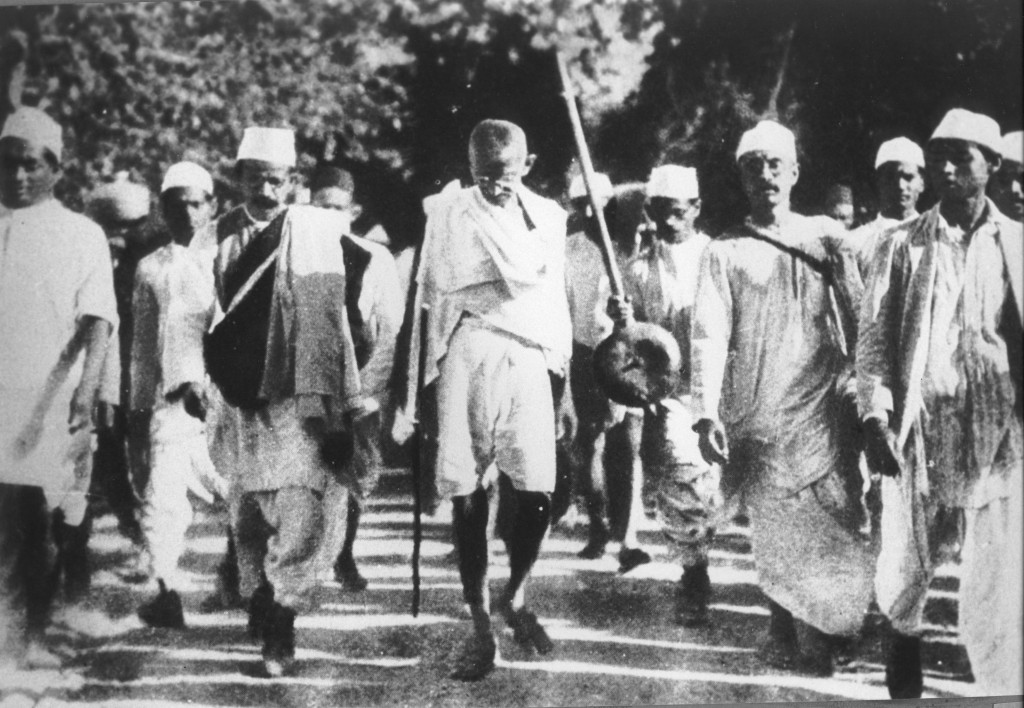by Rosemary Morrow
“It is, perhaps, the greatest failure of collective leadership since the first world war. The Earth’s living systems are collapsing, and the leaders of some of the most powerful nations – the US, the UK, Germany, Russia – could not even be bothered to turn up and discuss it. Those who did attend the Earth summit last week solemnly agreed to keep stoking the destructive fires: sixteen times in their text they pledged to pursue “sustained growth”, the primary cause of the biosphere’s losses.”
This was the opening paragraph by George Monbiot in the Guardian (25 June 2012) at the end of the Earth Summit convened to rescue all life from global climate change and other degradation. Those of us who follow the science feel dismayed.
Yet it has left us with only one path, that of ahimsa, nonviolence and almost certainly civil disobedience. As with M. Gandhi’s struggle for independence, we must be prepared to break the laws. We must disregard those who have no care for Nature and Life as we know it. We must abandon any sense that we will be saved by others. We must act as Earth’s residents, to restore Earth’s living systems, impelled by kindness, compassion and conscience for Nature.
Read the rest of this article »
by C. E. M. Joad
In what consists the most characteristic quality of our species? Some would say, in moral virtue; some, in godliness; some, in courage; some, in the power of self-sacrifice. Aristotle found it in reason. It was by virtue of our reason that, he held, we were chiefly distinguished from the brutes. Aristotle’s answer gives, I suggest, part of the truth, but not the whole. The essence of reason lies in objectivity and detachment. It is reason’s pride to face reality, when the garment of make-believe, with which pious hands have hidden its uglier features, has been stripped away. In a word, the reasonable man is a man unafraid; unafraid to see things as they are, without weighing the scales in his own favour, allowing desire to dictate conclusion, or hope to masquerade as judgment.
The reasonable man, then, is detached: detached, that is to say, from the subject-matter which his reason investigates.
Read the rest of this article »
by Dr. L. M. Singhvi
The Jain tradition, which enthroned the philosophy of ecological harmony and non-violence as its lodestar, flourished for centuries side by side with other schools of thought in ancient India. It formed a vital part of the mainstream of ancient Indian life, contributing greatly to its philosophical, artistic and political heritage. During certain periods of Indian history, many ruling elites as well as large sections of the population were Jains, followers of the Jinas (Spiritual Victors).
The ecological philosophy of Jainism, which flows from its spiritual quest, has always been central to its ethics, aesthetics, art, literature, economics and politics. It is represented in all its glory by the 24 Jinas or Tirthankaras (Pathfinders) of this era whose example and teachings have been its living legacy through the millennia.
Although the ten million Jains estimated to live in modern India constitute a tiny fraction of its population, the message and motifs of the Jain perspective, its reverence for life in all forms, its commitment to the progress of human civilization and to the preservation of the natural environment continues to have a profound and pervasive influence on Indian life and outlook.
In the twentieth century, the most vibrant and illustrious example of Jain influence was that of Mahatma Gandhi, acclaimed as the Father of the Nation. Gandhi’s friend, Shrimad Rajchandra, was a Jain. The two great men corresponded, until Rajchandra’s death, on issues of faith and ethics. The central Jain teaching of ahimsa (non-violence) was the guiding principle of Gandhi’s civil disobedience in the cause of freedom and social equality. His ecological philosophy found apt expression in his observation that the greatest work of humanity could not match the smallest wonder of nature.
Read the rest of this article »
by Dr. Saroj Kothari
Jain symbol; word ahimsa
within wheel of life; hand symbolizes vow;
courtesy commons.wikimedia.org
Violence and nonviolence
Today, all individuals, groups and nations are facing problems in one form or the other. Some of these problems are: psychological tension arising from economic inequity and the consumer culture; social problems and disintegration of society originating from conflicts of ideologies and faiths; political problems such as arms race, war and terrorism; and problems of human survival linked to production and ecological balance. The world is torn by tension, strife, crime and regional conflicts. Everybody is suffering from uncertainty about the future and lack of peace of mind. Many individuals, including social and political leaders, are trying to find solutions to their problems. They feel that scientific research and technological advances, nuclear weapons and improved war technology, consolidation of power and acquisition of material possessions, and concentrating on their own religious and ethnic groups will provide solutions to their problems. Religion emphasizes that peace of mind comes from tolerance and contentment. Morals and spiritual values including virtues such as nonviolence and truth can lead to genuine peace. However, to a large extent, these virtues are ignored on account of the glitter of materialism fueled by greed and the desire to get ahead of others. No doubt, scientific and technological advances have made human life, especially for those with material means, quite pleasant. Nevertheless, most people on earth have no peace of mind. In spiritual terms, one can say that we are living for the satisfaction of our animal instincts only. We do talk of higher moral, social and spiritual values but we fail to realize that material progress alone cannot lead to a resolution of conflicts arising from our selfish nature.
Read the rest of this article »
by Vandana Shiva

Gandhi on the Salt March, 1930.
In Hind Swaraj, Gandhi exhorts using ‘soul force’ as a means to seek ‘right livelihood’ – which is what real freedom is all about. Gandhi’s Hind Swaraj has, for me, been the best teaching on real freedom. It teaches the gospel of love in place of hate. It replaces violence with self-sacrifice. It puts ‘soul force’ against brute force. For Gandhi, slavery and violence were not just a consequence of imperialism: a deeper slavery and violence were intrinsic to industrialism, which Gandhi called “modern civilisation”.He identified modern civilisation as the real cause of loss of freedom. “Civilisation seeks to increase bodily comforts and it fails miserably even in doing so… This civilisation is such that one has only to be patient and it will be self-destroyed.”
Read the rest of this article »
Negley FARSON (Special Correspondent for India), The Chicago Daily News:
Bombay, June 21, 1930.
Heroic, bearded Sikhs, several with blood dripping from their mouths, refusing to move or even to draw their ‘kirpans’ (sacred swords) to defend themselves from the shower of lathi blows.
Hindu women and girls dressed in orange robes of sacrifice, flinging themselves on the bridles of horses and imploring mounted police not to strike male Congress volunteers, as they were Hindus themselves.
Stretcher-bearers waiting beside little islands of prostrate unflinching, immovable Satyagrahis, who had flung themselves on the ground grouped about their women upholding the flag of Swaraj (home-rule).
These were the scenes on the Maidan Esplanade, Bombay’s splendid seafront park, where the six-day deadlock between police and Mahatma Gandhi’s followers has broken out in a bewildering brutal and stupid yet heroic spectacle.
Read the rest of this article »
Webb MILLER (Special UP Correspondent for India), The New York World-Telegram, Dharasana Camp, Surat District, Bombay Presidency, May 22, 1930.
Amazing scenes were witnessed yesterday when more than 2,500 Gandhi ‘volunteers’ advanced against the salt pans here in defiance of police regulations. The official government version of the raid, issued today, stated that ‘from Congress sources it is estimated 170 sustained injuries, but only three or four were seriously hurt.’
About noon yesterday I visited the temporary hospital in the Congress camp and counted more than 200 injured lying in rows on the ground. I verified by personal observation that they were suffering injuries. Today even the British owned newspapers give the total number at 320 …
The scene at Dharasana during the raid was astonishing and baffling to the Western mind accustomed to see violence met by violence, to expect a blow to be returned and a fight result. During the morning I saw and heard hundreds of blows inflicted by the police, but saw not a single blow returned by the volunteers. So far as I could observe the volunteers implicitly obeyed Gandhi’s creed of non-violence. In no case did I see a volunteer even raise an arm to deflect the blows from lathis. There were no outcries from the beaten Swarajists, only groans after they had submitted to their beating.
Read the rest of this article »
by Étienne Balibar
The theme I shall address today has all the trappings of an academic exercise. Still, I would like to attempt to show how it intersects with several major historical, epistemological and ultimately political questions. As a basis for the discussion, I will posit that Lenin and Gandhi are the two greatest figures among revolutionary theorist–practitioners of the first half of the twentieth century, and that their similarities and contrasts constitute a privileged means of approach to the question of knowing what ‘being revolutionary’ meant precisely, or, if you prefer, what it meant to transform society, to transform the historical ‘world’, in the last century. This parallel is thus also a privileged means of approach to characterizing the concept of the political that we have inherited, and about which we ask in what senses it has already been and still needs to be transformed. Naturally, such an opening formulation – I was going to say, such an axiom – involves all sorts of presuppositions that are not self-evident. Certain of them will reappear and will be discussed along the way; others will require further justification. Allow me briefly to address several of them.
Read the rest of this article »
by Gene Sharp
Violence in society and politics, whether in the form of war, terrorism, dictatorship, oppression, usurpation, or genocide, is widely recognized as a grave problem.
All the proposals to solve the problem of violence, or particular expressions of it, have been unsuccessful. It is probable that the problem remains unsolved because such proposals have been based on inadequate understandings of its nature. Without understanding a problem, it is difficult, if not impossible, to solve it.
The objective of this essay is to explore a different perspective on the nature of the problem of widespread violence in society and politics that suggests what will be required for its resolution.
Read the rest of this article »
by Gene Sharp
THE METHODS OF NONVIOLENT PROTEST AND PERSUASION
Formal Statements
1. Public Speeches
2. Letters of opposition or support
3. Declarations by organizations and institutions
4. Signed public statements
5. Declarations of indictment and intention
6. Group or mass petitions
Read the rest of this article »






